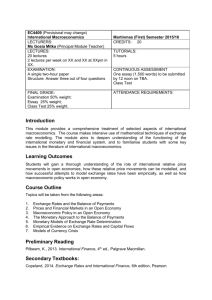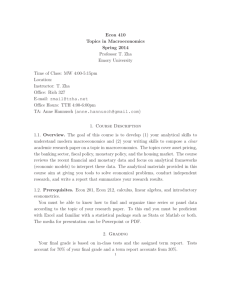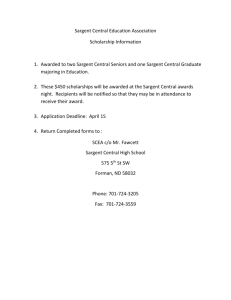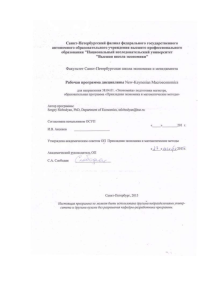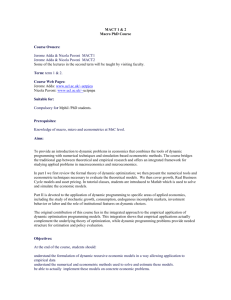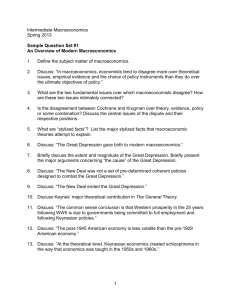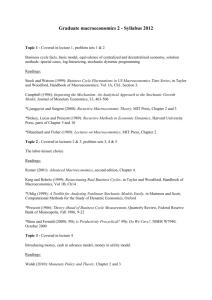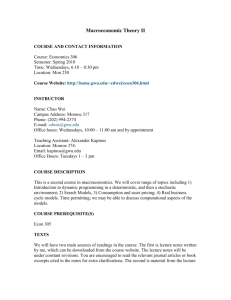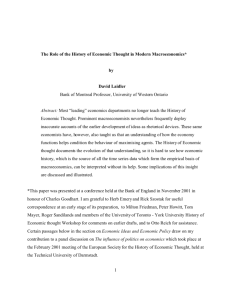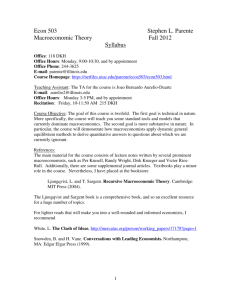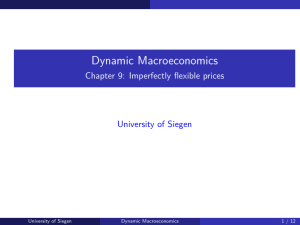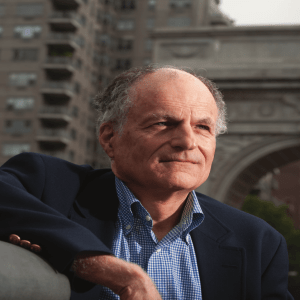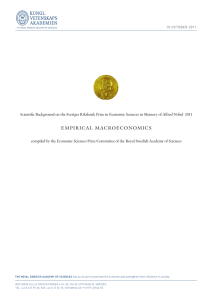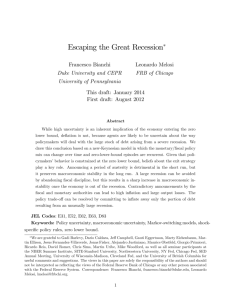Macroeconomics from an Historical Perspective
advertisement
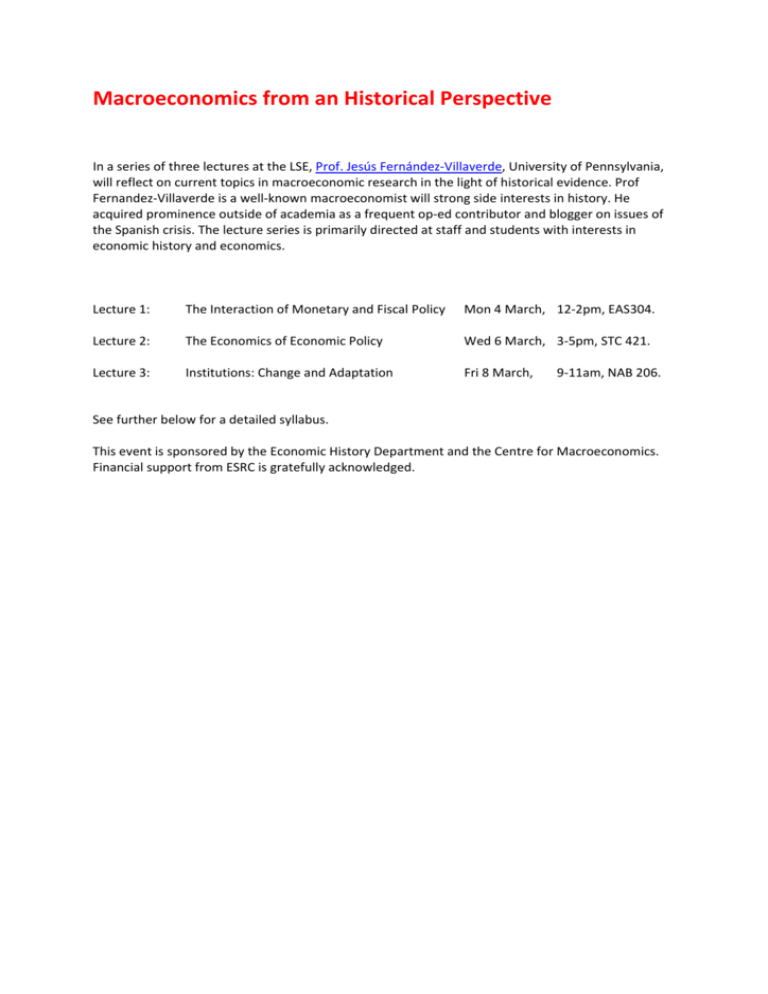
Macroeconomics from an Historical Perspective In a series of three lectures at the LSE, Prof. Jesús Fernández‐Villaverde, University of Pennsylvania, will reflect on current topics in macroeconomic research in the light of historical evidence. Prof Fernandez‐Villaverde is a well‐known macroeconomist will strong side interests in history. He acquired prominence outside of academia as a frequent op‐ed contributor and blogger on issues of the Spanish crisis. The lecture series is primarily directed at staff and students with interests in economic history and economics. Lecture 1: The Interaction of Monetary and Fiscal Policy Mon 4 March, 12‐2pm, EAS304. Lecture 2: The Economics of Economic Policy Wed 6 March, 3‐5pm, STC 421. Lecture 3: Institutions: Change and Adaptation Fri 8 March, 9‐11am, NAB 206. See further below for a detailed syllabus. This event is sponsored by the Economic History Department and the Centre for Macroeconomics. Financial support from ESRC is gratefully acknowledged. Macroeconomics from a Historical Perspective Jesús Fernández-Villaverde University of Pennsylvania Spring 2013 This is a series of three lectures (6 hours) that will introduce some topics at the core of the discussion in modern macroeconomics. The lectures will try to link these topics with the historical evidence. Therefore, the lectures will involve both analytic and historical arguments and are designed more to ask questions for future research than to o¤er de…nitive answers. For the material, I will borrow from my own research, my teaching at Penn, and from issues I am currently thinking about, but I hope to students’ participation will lead to a lively conversation that can take us to new places. 1. Outline Lecture 1: The Interaction between Fiscal and Monetary Policy. Lecture 2: The Economics of Economic Policy: Political Economy versus Learning. Lecture 3: Institutions: Change and Adaptation. 2. Meetings Lecture 1: Monday, March, 4th, 12noon-2pm, EAS 304. Lecture 2: Wednesday, March, 6th, 3-5pm, STC 421. Lecture 3: Friday, March, 8th, 9-11am, NAB 206. 3. Lecture 1 Most textbooks in macroeconomics neatly separate …scal and monetary policy in two di¤erent …elds. However, as Sargent and Wallace (1981) famous Unpleasant Monetarist Arithmetic paper shows, …scal and monetary policy are always deeply linked. The recent exercises on unconventional monetary policy and the Euro crisis have made this point more salient than ever, with the balance sheet of central banks becoming a central instrument of policy. In this lecture, we will explain why one cannot think about monetary and …scal policy as separated entities and we will link the current policy debate with the historical evidence from the 1920s and 1930s. 1 References [1] Sargent, T.J. (1986). “The End of Four Big In‡ations.”In T.J. Sargent, Rational Expectations and In‡ation. Harper and Row. [2] Sargent, T.J. and N. Wallace (1981). “Some Unpleasant Monetarist Arithmetic.” Quarterly Review, Federal Reserve Bank of Minneapolis, Fall. [3] Sargent, T.J. and N. Wallace (1982). “The Real Bills Doctrine versus the Quantity Theory: A Reconsideration.”Journal of Political Economy 90, 1212-36. [4] Wallace, N. (1981). “A Modigliani-Miller Theorem for Open-Market Operations.”American Economic Review 71, 267-74. 4. Lecture 2 How do countries decide which economic policy to adopt? There are two basic paradigms to think about this process. One paradigm, political economy, emphasizes that economic policy is the outcome of a political-economic equilibrium in which di¤erent interest groups interact to enact legislation that is favorable to their interests. A second paradigm, less common in economics, highlights the problem of limited information and learning in real time about the true state of the economy. In this lecture, we will compare both paradigms and use them to think about fast changes in economic policy as those that occurred in the 1930s and in 1970s in Western Countries. Which paradigm is more useful to think about the data? Should we integrate both? References [1] Buera, F.J., A. Monge-Naranjo, and G.E. Primiceri (2011). “Learning the Wealth of Nations.”Econometrica 79, 1-45. [2] Cho, In-Koo, N. Williams, and T.J. Sargent (2002). “Escaping Nash In‡ation.” Review of Economic Studies 69, 1-40. [3] Evans, G.W. and S. Honkapohja (2001). Learning and Expectations in Macroeconomics. Princeton University Press. [4] Fudenberg, D. and D.K. Levine (1995). “Self-Con…rming Equilibrium.”Econometrica 61, 523-545. 2 5. Lecture 3 Over the last few years, institutions have come to the front of the discussions regarding economic growth. Many researchers, most famously Daron Acemoglu and Jim Robinson, have argued that institutions are key to understand why some nations grow while other stagnate. However, institutions are not …xed over time: they constantly change and adapt. Moreover, economists lack a good theory of institutional change and can o¤er little advise along those lines. In this lecture, we will evaluate the evidence for the importance of institutions and discuss historical examples of deep institutional changes, such as the American Revolution, the Meiji Restoration, or the transition to democracy of Mediterranean countries in the 1970s. How and when do we observe institutional change? How do groups overcome collective action problems? Do institutional changes seed their own demise in the future? What advise can we o¤er to societies trap in bad institutional arrangements? References [1] Acemoglu, D., G. Egorov, and K. Sonin (2012). “Dynamics and Stability of Constitutions, Coalitions, and Clubs.”American Economic Review 102, 1446-76. [2] Acemoglu, D. (2012). Success and Failure of Nations: Modeling Ine¢ cient Institutions. Zeuthen Lectures. Available at http://economics.mit.edu/files/7847. [3] Jackson, M.O. and S. Wilkie (2005). “Endogenous Games and Mechanisms: Side Payments among Players.”Review of Economic Studies 72, 543-566. 3
